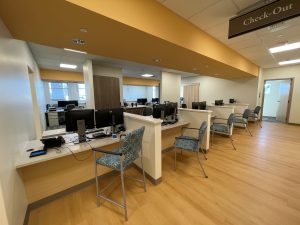Healthcare design has come a long way, and for good reason. Medical spaces today are expected to do more than house equipment and staff. They need to support healing, operate efficiently, and keep up with changing technologies. Whether you’re adding onto a hospital, renovating a clinic, or building something entirely new, smart planning can make all the difference.
In the Lehigh Valley, where healthcare service expansion continues, commercial construction teams have to think ahead. Trends move quickly, patient needs shift, and regulations tighten. Working with professionals who understand these moving parts helps to keep your project on track and on budget. Below are seven trends shaping the future of healthcare construction and what you should know before getting started with your project.
1. Patient-Centered Design
Creating a space that feels calm, intuitive, and accessible goes a long way. Thoughtful lighting, soundproofing, clear signage, and private areas all play a part in reducing patient stress. And when the environment works for patients, it usually works better for staff, too.
Think beyond aesthetics in your designs. When medical teams can move easily between rooms, find what they need, and communicate without barriers, care improves. Contractors and designers who focus on layout efficiency and user experience create spaces that truly support everyone inside.
Patient-centered design also improves staff workflow and job satisfaction. Staff fatigue and burnout can often be traced back to poor layouts and inefficient space usage. Smart design leads to better outcomes for everyone in the building.
And let’s not forget families. A facility that considers family spaces (comfortable seating, quiet zones, and privacy for discussions) can significantly improve the patient experience. Designing for everyone who walks through the doors creates a more holistic, supportive atmosphere.
2. Flexible, Multi-Use Spaces
Healthcare needs aren’t static. One year, your facility might need extra exam rooms. The next, those spaces could be better used for telehealth or testing. Building with flexibility in mind keeps your options open.
That might mean using movable walls, leaving access panels for future wiring, or designing rooms that meet multiple needs. Contractors who plan for change before construction even starts can help facilities stay functional and adaptable for the long haul.
Incorporating flexibility also allows facilities to pivot quickly in response to emergencies or changing patient loads. Rooms that can serve multiple purposes without major renovations are a long-term asset.
This flexibility extends beyond patient care areas. Staff workspaces, break rooms, and even waiting rooms benefit from a flexible, modular design that adapts to evolving operations or expanded services.
3. Infection Control and Health-Safe Materials
In healthcare settings, cleanliness is a requirement. From nonporous surfaces to hands-free doors and high-grade HVAC systems, every detail counts. A lot of these systems and materials sound high-tech, but the real challenge is in the execution: installing them properly, choosing finishes that stand up to constant cleaning, and making sure maintenance crews can access and disinfect hard-to-reach areas. Even the placement of outlets and baseboards matters.
Working closely with facility managers, infection control teams, and cleaning staff helps ensure that the space is not only clean on day one but easy to keep clean for years to come.
Materials matter. Durable flooring, antimicrobial coatings, seamless wall protection, and finishes that resist damage from disinfectants all add up to better infection control and longer-lasting spaces.
4. Technology That Works with the Building
Tech tools are everywhere in modern healthcare. Think digital check-in stations, mobile charting devices, virtual appointments, and smart building controls. But all that tech needs power, connectivity, and thoughtful integration.
Good contractors build infrastructure that supports tech without complicating things later. That includes access points, wiring pathways, and strong Wi-Fi signals across the facility. It also means making room for future upgrades, which are inevitable as technology continues to advance.
The best tech setups feel invisible. They work without drawing attention to themselves, allowing staff to focus on patients and patients to focus on getting better. Commercial construction teams need to collaborate with IT professionals from the start. Planning data closets, server room access, secure cabling, and redundancy for essential systems is just as critical as the layout of the exam rooms themselves.
5. Energy Efficiency and Sustainability
Healthcare buildings are on 24/7, which means their energy usage adds up fast. More and more projects are taking a sustainable approach, whether it’s to save money or meet environmental goals.
From efficient HVAC systems and low-flow plumbing to LED lighting and recycled building materials, small improvements can have a big impact. Some facilities aim for certifications like LEED, while others focus on the features that make the most sense for their budget.
Commercial contractors who know how to balance sustainability with cost and long-term performance can help owners make smart, forward-thinking decisions. Sustainability isn’t just a trend. It’s quickly becoming the standard.
In addition to energy savings, sustainable design can improve indoor air quality, daylight access, and the comfort of both patients and staff. These benefits often translate into higher satisfaction and lower long-term operational costs.
6. Behavioral Health-Informed Design
Healthcare systems increasingly recognize that a well-constructed environment can ease anxiety, reduce agitation, and foster faster healing. Children in pediatric wings feel less fear in spaces designed with warmth and softness. Seniors in memory care benefit from layouts that are both calming and intuitive. Even in fast-paced ERs, construction choices that support spatial clarity, controlled lighting, and noise management can make a measurable difference.
Mental wellness design also supports those behind the scenes. Nurses, techs, and physicians working long shifts in high-pressure environments benefit from facilities that are quiet, naturally lit, and thoughtfully zoned. For commercial construction teams, this means collaborating closely with architects and healthcare administrators to ensure every material, finish, and spatial decision supports well-being.
As demand grows for healing-centric spaces, commercial contractors who understand and implement these mental wellness principles are shaping the future of care.
Construction teams that understand behavioral health design can help shape environments that feel secure without being institutional. Think spaces that promote healing and trust.
This approach includes everything from secure furniture and tamper-resistant hardware to thoughtful room proportions and visual access points for staff. A well-designed space can help prevent incidents and de-escalate situations before they start.
7. Smarter Commercial Construction Schedules
Most healthcare facilities can’t shut down completely during a renovation. That’s where phased construction comes in and breaks projects into sections so the facility stays operational while work happens.
This takes careful planning. Teams need to coordinate with hospital staff, ensure safety during construction, and stay flexible if priorities shift mid-project. It also helps to use modular components or pre-fab assemblies to speed up timelines without sacrificing quality.
For healthcare settings, this is also where ICRA (Infection Control Risk Assessment) becomes critical. Contractors work with hospital teams to assess patient risk levels, set up proper containment, and control air quality so dust and airborne particles don’t impact vulnerable populations. The right ICRA plan keeps construction moving while maintaining a safe environment for patients, providers, and visitors.

A commercial contractor with experience in live healthcare environments knows how to get the job done with minimal disruption and maximum respect for patients and providers.
Smarter schedules also lead to better outcomes. When timelines are realistic and well-communicated, everyone (staff, contractors, and administrators) can work more effectively. Another benefit of phased construction is continuity. Patients stay in familiar environments. Staff routines remain intact. And, construction crews can work more efficiently with fewer interruptions.
Building Smarter, Healing Better
Healthcare construction isn’t easy, but it’s worth doing right. When buildings are designed and built with care, they support better outcomes, safer environments, and more efficient operations.
At Jerdon Construction, we’ve worked on healthcare projects across the Lehigh Valley, helping facilities grow, modernize, and prepare for the future. Whether it’s a small clinic renovation or a major hospital expansion, we bring experience, professionalism, and a deep understanding of healthcare priorities.
If you’re planning a project, we’re ready to help you build something that lasts. Something that works for staff supports patient care and stands the test of time.
Looking to get started? Reach out to the Jerdon Construction team and see how we can help move your vision forward.



